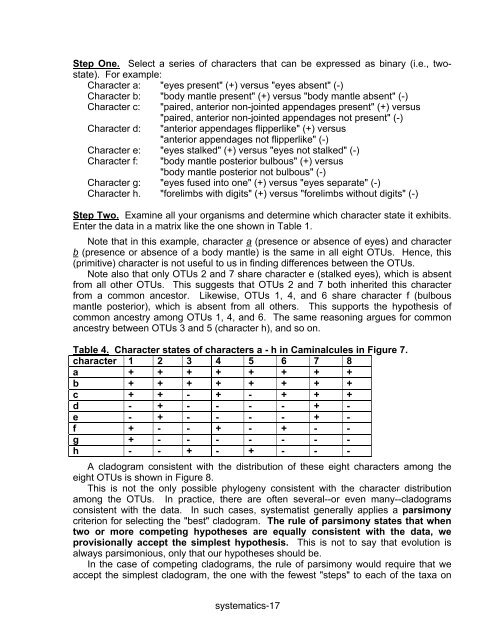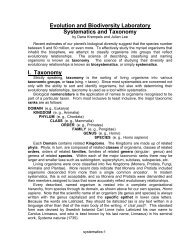Evolution and Biodiversity Laboratory Systematics and Taxonomy
Evolution and Biodiversity Laboratory Systematics and Taxonomy
Evolution and Biodiversity Laboratory Systematics and Taxonomy
Create successful ePaper yourself
Turn your PDF publications into a flip-book with our unique Google optimized e-Paper software.
Step One. Select a series of characters that can be expressed as binary (i.e., twostate).For example:Character a: "eyes present" (+) versus "eyes absent" (-)Character b: "body mantle present" (+) versus "body mantle absent" (-)Character c: "paired, anterior non-jointed appendages present" (+) versus"paired, anterior non-jointed appendages not present" (-)Character d: "anterior appendages flipperlike" (+) versus"anterior appendages not flipperlike" (-)Character e: "eyes stalked" (+) versus "eyes not stalked" (-)Character f:"body mantle posterior bulbous" (+) versus"body mantle posterior not bulbous" (-)Character g: "eyes fused into one" (+) versus "eyes separate" (-)Character h. "forelimbs with digits" (+) versus "forelimbs without digits" (-)Step Two. Examine all your organisms <strong>and</strong> determine which character state it exhibits.Enter the data in a matrix like the one shown in Table 1.Note that in this example, character a (presence or absence of eyes) <strong>and</strong> characterb (presence or absence of a body mantle) is the same in all eight OTUs. Hence, this(primitive) character is not useful to us in finding differences between the OTUs.Note also that only OTUs 2 <strong>and</strong> 7 share character e (stalked eyes), which is absentfrom all other OTUs. This suggests that OTUs 2 <strong>and</strong> 7 both inherited this characterfrom a common ancestor. Likewise, OTUs 1, 4, <strong>and</strong> 6 share character f (bulbousmantle posterior), which is absent from all others. This supports the hypothesis ofcommon ancestry among OTUs 1, 4, <strong>and</strong> 6. The same reasoning argues for commonancestry between OTUs 3 <strong>and</strong> 5 (character h), <strong>and</strong> so on.Table 4. Character states of characters a - h in Caminalcules in Figure 7.character 1 2 3 4 5 6 7 8a + + + + + + + +b + + + + + + + +c + + - + - + + +d - + - - - - + -e - + - - - - + -f + - - + - + - -g + - - - - - - -h - - + - + - - -A cladogram consistent with the distribution of these eight characters among theeight OTUs is shown in Figure 8.This is not the only possible phylogeny consistent with the character distributionamong the OTUs. In practice, there are often several--or even many--cladogramsconsistent with the data. In such cases, systematist generally applies a parsimonycriterion for selecting the "best" cladogram. The rule of parsimony states that whentwo or more competing hypotheses are equally consistent with the data, weprovisionally accept the simplest hypothesis. This is not to say that evolution isalways parsimonious, only that our hypotheses should be.In the case of competing cladograms, the rule of parsimony would require that weaccept the simplest cladogram, the one with the fewest "steps" to each of the taxa onsystematics-17

















